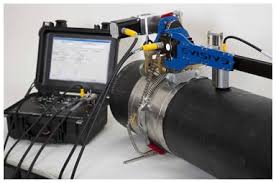Concrete crack inspection is a crucial aspect of maintaining the structural integrity of buildings and infrastructure. In Egypt, advanced no...
Concrete crack inspection is a crucial aspect of maintaining the structural integrity of buildings and infrastructure. In Egypt, advanced non-destructive testing (NDT) methods have been developed to provide more accurate and efficient ways of identifying and assessing concrete cracks. These methods offer a non-invasive approach to inspecting concrete structures, reducing the need for costly and time-consuming destructive methods. In this paper, we will explore the inspection and testing of welds latest developments in advanced non-destructive concrete crack inspection methods in Egypt, with a focus on the use of NDT techniques for evaluating the condition of concrete structures.
Advanced non-destructive concrete crack inspection methods in Egypt include technologies such as ground-penetrating radar ndt laboratory (GPR), ultrasonic testing, and infrared thermography. These methods allow for the detection and evaluation of cracks and other defects in concrete structures without causing any damage to the material. GPR uses high-frequency electromagnetic waves to map subsurface features, while ultrasonic testing utilizes sound waves to detect flaws and measure crack depth. Infrared thermography, on the other hand, detects temperature variations on the surface of concrete, which can indicate the presence of cracks or other structural issues. These advanced non-destructive methods are essential for ensuring the safety and integrity of concrete structures in Egypt.
Importance of Concrete Crack Inspection NDT Egypt

Concrete crack inspection using non-destructive testing (NDT) methods is crucial for assessing the structural integrity of concrete structures in Egypt. NDT techniques such as ultrasonic testing, ground-penetrating radar, and thermal imaging can help identify and evaluate concrete cracks without causing further damage to the structures. This allows for early detection of potential issues, minimizing the risk of structural failure and ensuring the safety and longevity of the infrastructure. Additionally, NDT inspection can help in determining the extent and cause of concrete cracking, allowing for targeted repairs and maintenance. Overall, the importance radiographic inspection of welds of concrete crack inspection NDT in Egypt cannot be overstated, as it plays a vital role in ensuring the reliability and durability of concrete structures in the country.
Methods for Concrete Crack Inspection NDT Egypt

Methods for concrete crack inspection using non-destructive testing (NDT) in Egypt include visual inspection, ultrasonic testing, and ground-penetrating radar (GPR). Visual inspection involves a thorough visual examination of the concrete surface to identify any visible cracks or signs of distress. Ultrasonic testing uses high-frequency sound waves to detect and evaluate the depth and extent of cracks within the concrete. GPR is a geophysical method that uses radar pulses to image the subsurface and locate any anomalies or voids within the concrete. These NDT methods are commonly used in Egypt to assess the condition of concrete structures and determine the extent of any cracks or defects present. By utilizing these techniques, engineers and inspectors can identify potential issues and develop appropriate repair and maintenance plans to ensure the structural integrity and longevity of concrete infrastructure in Egypt.
Challenges in Concrete Crack Inspection NDT Egypt
inspection and testing of welds

Concrete crack inspection in Non-Destructive Testing (NDT) in Egypt faces various challenges, including the need for experienced and skilled technicians to perform the inspection accurately. Additionally, the harsh environmental conditions in Egypt, such as extreme heat and sandstorms, can affect the reliability of NDT equipment and the accuracy of crack detection. Furthermore, the wide range of concrete types and construction methods in Egypt adds complexity to the inspection process. Ensuring proper training and equipment maintenance, as well as adapting inspection techniques to local conditions, are essential for successful concrete crack inspection in NDT in Egypt.
Advancements in Concrete Crack Inspection NDT Egypt
Advancements in concrete crack inspection NDT in Egypt involve the use of non-destructive testing (NDT) methods such as ultrasonic testing, infrared thermography, ground-penetrating radar, and acoustic emission techniques. These methods allow for the detection and evaluation of cracks in concrete structures without causing any damage to the material. By utilizing these advanced NDT technologies, engineers and inspectors in Egypt are able to accurately assess the condition of concrete infrastructure and identify potential issues before they become major problems. This ultimately helps to enhance the safety and durability of concrete structures in Egypt.
Training for Concrete Crack Inspection NDT Egypt
Training for Concrete Crack Inspection NDT in Egypt is a specialized program designed to provide professionals with the skills and knowledge necessary to inspect and evaluate concrete structures for cracks and defects using non-destructive testing (NDT) methods. The training covers topics such as visual inspection techniques, NDT methods including ultrasonic testing and ground-penetrating radar, interpretation of test results, and reporting. Participants will also learn about industry standards and best practices for concrete crack inspection. The course is ideal for engineers, construction professionals, and quality control inspectors working in the construction and infrastructure sectors in Egypt.
Case Studies on Concrete Crack Inspection NDT Egypt
inspection and testing of welds
The case study on concrete crack inspection NDT in Egypt focused on evaluating the effectiveness of non-destructive testing (NDT) techniques for detecting and analyzing cracks in concrete structures. The study involved using advanced NDT methods such as ultrasonic testing, ground-penetrating radar, and digital imaging to inspect and assess the condition of concrete in various infrastructure projects across Egypt. The findings of the case study highlighted the importance of implementing NDT for early detection and accurate assessment of concrete crack formations, enabling timely repair and maintenance to ensure the structural integrity and safety of the infrastructures. The successful application of NDT techniques in Egypt demonstrated their potential in improving the quality and durability of concrete structures in the region.
Future of Concrete Crack Inspection NDT in Egypt
Concrete crack inspection through non-destructive testing (NDT) is steadily gaining importance in Egypt's construction industry. The use of NDT techniques such as ultrasonic testing, ground-penetrating radar, and infrared thermography is allowing for more accurate and efficient inspection of concrete structures. As Egypt continues to develop its infrastructure and expand its construction projects, the need for reliable and advanced crack inspection methods will only grow. NDT is seen as the future of concrete crack inspection in Egypt, offering a cost-effective and non-invasive way to assess the integrity of concrete structures. As technology continues to advance, we can expect to see even more sophisticated NDT methods being utilized in Egypt's construction industry for concrete crack inspection.


ليست هناك تعليقات